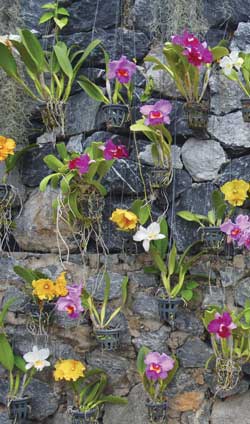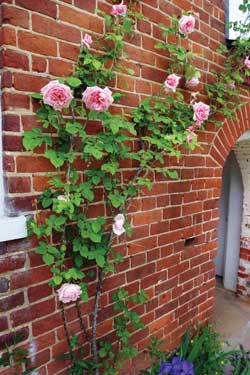
Vertical Gardening
Download a PDF of this fact sheet.

Growing your garden 'up' puts plants at eye-level. Weeding, watering, pruning, harvesting, checking for pests, and enjoying flowers are easier because you are not bending over or kneeling. There are many things that can support plants growing vertically. Trellises, tripods, arches, gazebos, walls, wire cages, netting, and poles are commonly used.
Vining and sprawling plants do well growing up and off the ground. Cucumbers, tomatoes, pole beans, and melons do especially well. Some plants, like peas, will naturally attach themselves to structures. Other plants, like tomatoes, will need to be tied. Cloth strips are best to tie plants because they do not cut into plants like string can.
Where you place plants to grow vertically can affect other plants. Growing plants up can cast a shadow. Sun-loving plants may not grow well next to vertical plants or their support structure because of the casting shadow. Instead, shadeloving plants may do well in these areas.
You may find you have to water vertically growing plants more frequently. Plants growing vertically expose the soil underneath them, which causes the soil to dry 6/2011 out faster.
Considerations

Growing plants vertically is not much different than letting plants grow along the ground. There are some things to keep in mind when deciding what type of support structure to use for your vertical plants.
- What structure you use depends on what plant you want to grow. The structure has to be able to support the plant's weight. It must be anchored well into the ground to keep it from being pulled down by the plant. Otherwise, the structure may damage the plant.
- You can make or buy trellises to fit any space. They can be staked into the ground or attached to a wall. Make sure to leave space between the wall and trellis for air circulation. Otherwise, mold can grow and spread diseases to your plants.
- Arches are good for heavier plants, like grape and wisteria vines, climbing plants, and hanging baskets.
- Think about sun and weather exposure, size, and plant care when choosing which plants to grow vertically.
- Do you want plants year-round or do you want a garden just in the summer? Plants that live year round tend to be larger. Those that live only in the summer are usually smaller.
- Where do you want your plants to grow? Up a wall in full sun or in shade? What is the typical weather where you live? This will help you decide which plants will grow best in the area where you want your plants to grow.
- Think about the different kind of plant care you will need to give to vertical plants. Will you need to prune and tie your plants more often since they will be at eye level? Will you need them to grow on trellises so they don't fall off? Will you need to use a ladder to prune or are the plants within easy reach?
- Match the supporting structure to the plant's characteristics.
- Plants with tendrils do well growing on trellises and tripods, like pole beans.
- Plants that twine need wire or string to twist around. An example of this is string hanging above a row of peas to keep the plants off the ground.
- Some vines will hold onto any rough surface; but can damage wood, paint and mortar. Ivy often causes damage to brick walls.
- Make sure plants do not grow where you do not want them to. Morning glories are well known for attaching themselves to gutters and pulling them off because of their weight.
- Some plants must be tied; otherwise, they will only grow along the ground, like tomatoes.
- Vining varieties do better at growing vertically than bush varieties. Some vegetables, such as beans, peas, cucumbers and squash come in both varieties.
- Small-fruited varieties of squashes, melons and pumpkins also do well in vertical gardens. Squashes and melons may need to be supported by 'slings' to support their weight while maturing. Slings can be made with panty hose and rags.

Resources
There are many resources available on vertical gardening, also called intensive gardening. Virginia's Extension Service has several articles on vertical garden designs and growing tips. Look for them under 'intensive gardening' and 'container gardening' in the garden and landscape design section at www.pubs.ext.vt.edu.
Washington State University also has a lot of information on vertical gardening. Check out their 'garden mastery tips' archives, especially June 2005, for their suggestions by visiting http://clark.wsu.edu/volunteer/mg.
If you would like to talk to someone about accessible gardening, or would like a garden assessment done, call Green Thumbs, Healthy Joints at 800-841-8436.

